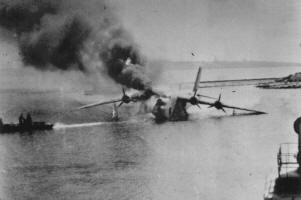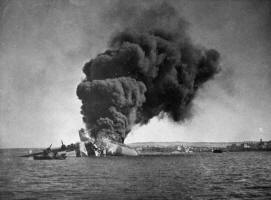|
The Sunderland flying
boat was the RAF’s longest serving operational aircraft. It was
first delivered to No 230 Squadron in Singapore back in June 1938.
First flown on 16th October 1937 and was powered by 790hp
Pegasus X engines. It entered production with Pegasus XXII and a
revised nose and tail armament. By 3rd September 1939
forty were in service with four RAF squadrons. Ninety Mk1s were
eventually completed including fifteen built by Blackburn.
At the end of 1941
the Sunderland Mk II began to replace the Mk I. These were powered
by Pegasus XVIII engines; with two stage superchargers; a twin gun
Botha-type dorsal turret in place of the ‘midship gun ports; an
improved tail-turret and ASV radar. Rising operating weights now
necessitated redesign of the hull planning bottom, and the Mk II on
which this was tested thus became the prototype for the chief
production model, the Sunderland Mk III. The first Short built Mk
III flew on 15th December 1942 and 286 were produced and
a further 170 built by Blackburn.
The roles of islands
of Gibraltar and Malta were critical to allied strategy and survival
in this theatre during the war. Two aircraft left Pembroke Dock for
Malta on the 29th of April 1940. The outbreak of war saw
three Sunderlands at Malta and four more aircraft moved to Malta on
the 9th of September. The following day four Sunderlands
flew back to Pembroke Dock.
With the outbreak of
war Sunderland flying boats based in Malta achieved a number of
successes against axis shipping and submarines and keeping a watch
on movement of the Italian fleet. While performing these missions
Sunderlands were also frequently jumped by Italian CR-42s and
Macchis, often shooting down the intruders for the cost of injured
crews and damage to the aircraft.
Mediterranean
Sunderland units were involved in first major battles
between the Royal Navy and the Italian fleet. In one such
incident taking place during the day, Flight Lieutenant
Woodward of 230 Squadron attacked and claimed a hit on an
Italian Submarine (probably Zoea), while Squadron Leader
Menzies was fired on by anti aircraft and engaged in a 30
minute running fight with an He-115, which eventually broke
off. Three days later Menzies attacked and claimed to have
sunk an unidentified Italian submarine (probably Settimo).
 |
 |
Sunderlands did not
always have things all their own way. On 25th July a
Sunderland, flown by Flt. Garside was attacked by three Fiat CR-42s.
The crew shot down one of the biplanes and scored hits on another.
The aircraft itself was heavily damaged and just struggled back to
Malta. On 28th July another aircraft was bounced by three
Macchi 200. Its crew claims to have shot down one and forced another
to break because of damage. Sqd Leader Riley was less lucky with
three gunners being wounded during an hour-long engagement with four
Macchis. The Sunderland struggled back to Malta where it was beached
to avoid sinking.
On 17th
September a Sunderland flown by Sq Leader Menzis turned aggressor
when its crew claims met a Cant Z-501 flying boat and shot it down
in flames. 230 Squadron Sunderland continued to monitor the Italian
fleet. Skirmishes and tales told by crew continued throughout the
war also while protecting convoys on their way to Malta.
Incidents also
involved Sunderlands being directly attacked at their bases in
Malta. During March and early April 1941 four Sunderlands were
strafed at their moorings at Kalafrana base and at St Paul’s Bay.
Two of the flying boats being destroyed by Oberleutenant Jouchim
Munchenburg. One such victim of an air raid on Kalafrana was a 228
Squadron Sunderland L5807 which caught fiercely after such attack.
This all happened
when on the 7th of March Sunderland L2149 of 228 Sq was
attacked at its Kalafrana moorings by two Bf109s. Sgt Jones acted as
boat guards and managed to get his Vickers gun into action before
being fatally hit. The Sunderland was badly damaged but it was in
trouble again later during another similar attack. Sunderland L2164
was damaged and T9046 caught fire. A party boarded the latter
aircraft, which apparently got the fire under control but after an
interval blazed up again. The aircraft was taxied and beached but
had to be abandoned and ultimately sunk.
L2164 was flown to St
Paul’s Bay and moored at the Mistra inlet of the bay. On the 10th
of March it was attacked and set alight by two Bf109s from 7/JG26.
The Sunderland has been rendered immobile during the strafing attack
by the Messerschmitt that belonged to the same Staffel, 72 hours
earlier. The aircraft sank when efforts were made to tow it ashore.
In 1964 myself and RAF flt sergeant Elliott dived at the same
location at Mistra sea and at around 18 feet of depth recovered a
piece of Sunderland hull; which we sent to Short brothers in Ireland
who confirmed that it came from a Sunderland but said had no other
records. They also sent us drawings of the retrieved part that
confirmed it came from part of the hull.
|